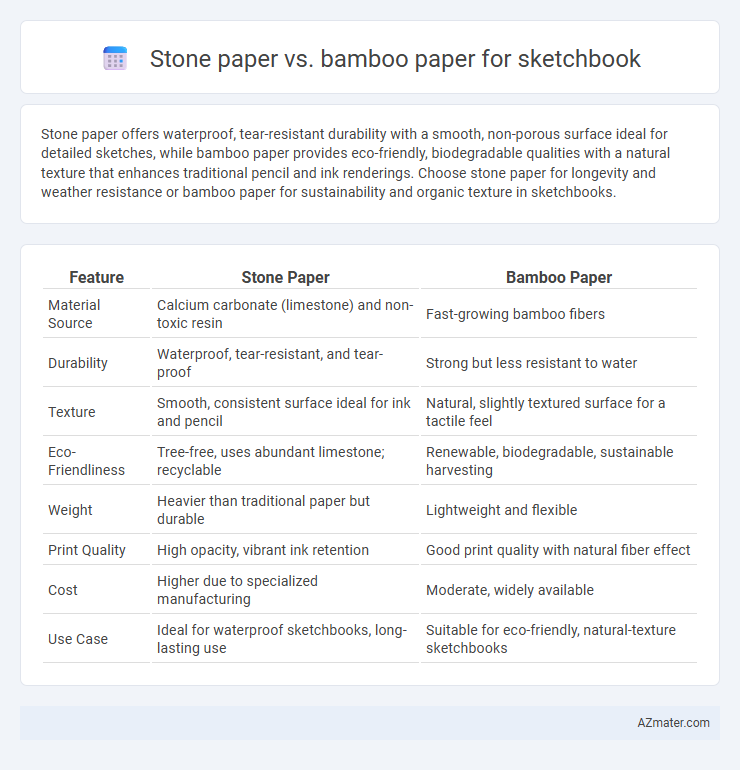Stone paper offers waterproof, tear-resistant durability with a smooth, non-porous surface ideal for detailed sketches, while bamboo paper provides eco-friendly, biodegradable qualities with a natural texture that enhances traditional pencil and ink renderings. Choose stone paper for longevity and weather resistance or bamboo paper for sustainability and organic texture in sketchbooks.
Table of Comparison
| Feature | Stone Paper | Bamboo Paper |
|---|---|---|
| Material Source | Calcium carbonate (limestone) and non-toxic resin | Fast-growing bamboo fibers |
| Durability | Waterproof, tear-resistant, and tear-proof | Strong but less resistant to water |
| Texture | Smooth, consistent surface ideal for ink and pencil | Natural, slightly textured surface for a tactile feel |
| Eco-Friendliness | Tree-free, uses abundant limestone; recyclable | Renewable, biodegradable, sustainable harvesting |
| Weight | Heavier than traditional paper but durable | Lightweight and flexible |
| Print Quality | High opacity, vibrant ink retention | Good print quality with natural fiber effect |
| Cost | Higher due to specialized manufacturing | Moderate, widely available |
| Use Case | Ideal for waterproof sketchbooks, long-lasting use | Suitable for eco-friendly, natural-texture sketchbooks |
Introduction to Stone Paper and Bamboo Paper
Stone paper is a durable, waterproof material made primarily from calcium carbonate bonded with non-toxic resin, offering a smooth, tear-resistant surface ideal for sketching. Bamboo paper, crafted from fast-growing bamboo fibers, provides a sustainable, eco-friendly option with a natural texture that enhances pencil and ink performance. Both materials present innovative alternatives to traditional wood-pulp paper, with stone paper excelling in strength and water resistance, while bamboo paper emphasizes biodegradability and renewable sourcing.
Environmental Impact: Stone vs Bamboo Paper
Stone paper production uses calcium carbonate and HDPE resin, requiring no trees or water, resulting in lower carbon emissions and zero deforestation compared to bamboo paper, which involves intensive water and pesticide use despite bamboo's fast growth. Bamboo paper biodegrades naturally, supporting soil health, whereas stone paper is durable and waterproof but less biodegradable, potentially causing long-term landfill impact. Choosing stone paper reduces reliance on forestry but poses recycling challenges, while bamboo paper offers a renewable resource with a more traditional environmental footprint.
Material Composition and Production Process
Stone paper is made primarily from calcium carbonate bonded with non-toxic resin, resulting in a waterproof, tear-resistant surface ideal for sketching with various media. Bamboo paper uses fibers extracted from bamboo plants, processed through pulping and bleaching to create a natural, biodegradable texture favored for its smoothness and sustainability. The production of stone paper consumes less water and avoids chemical bleaching, while bamboo paper production involves traditional pulping methods that rely on water and chemicals but support renewable agriculture.
Texture and Surface Quality for Sketching
Stone paper offers a smooth, non-porous surface with minimal texture, ideal for detailed pencil and ink sketches that require precision and clean lines. Bamboo paper features a naturally fibrous texture, providing a tactile grip that enhances shading and blending for mediums like charcoal and graphite. Both papers differ significantly in surface quality, with stone paper excelling in smoothness and bamboo paper delivering a textured feel that influences sketching techniques.
Durability and Resistance to Wear
Stone paper exhibits superior durability and resistance to wear compared to bamboo paper, thanks to its unique mineral composition that makes it tear-resistant and waterproof. Bamboo paper, while eco-friendly and sustainable, tends to be more prone to fraying and quicker wear under frequent use, especially with heavy sketching techniques. For artists requiring long-lasting sketchbooks that withstand extensive handling, stone paper offers enhanced strength and resilience.
Compatibility with Art Mediums (Pencil, Ink, Watercolor)
Stone paper offers excellent compatibility with pencil and ink, providing smooth, non-absorbent surfaces that prevent smudging and bleeding, but it struggles with watercolor due to poor absorption and potential pooling. Bamboo paper, made from natural fibers, excels with pencil, ink, and watercolor, as its textured surface absorbs water evenly, allowing vibrant washes and detailed line work without warping. Artists seeking a versatile sketchbook compatible with a wide range of mediums typically prefer bamboo paper for its balanced absorption and durability.
Weight, Thickness, and Portability
Stone paper is generally heavier and thicker than bamboo paper, offering a sturdy surface ideal for detailed sketching but potentially reducing overall portability. Bamboo paper tends to be lighter and thinner, enhancing sketchbook portability while maintaining a smooth texture suitable for quick sketches and less detailed work. Choosing between stone and bamboo paper depends on the balance of durability and ease of transport required for your sketching needs.
Cost Comparison: Stone Paper vs Bamboo Paper Sketchbooks
Stone paper sketchbooks typically cost more upfront due to their innovative manufacturing process using calcium carbonate, while bamboo paper sketchbooks are generally more affordable as they rely on renewable bamboo fibers. The durability and water-resistant properties of stone paper may justify its higher price for artists seeking longevity and tear resistance. Bamboo paper offers a cost-effective, eco-friendly alternative with sufficient quality for everyday sketching needs.
Availability and Popular Brands
Stone paper and bamboo paper for sketchbooks differ significantly in availability, with stone paper being less common and primarily produced by niche eco-friendly brands such as Rough and TreeZero. Bamboo paper enjoys wider distribution and accessibility, manufactured by established companies like Treetec and EcoPaper, making it easier to find in various art supply stores and online platforms. Both materials appeal to environmentally conscious artists, but bamboo paper's broader market presence offers more options for quality and price.
Final Verdict: Which Paper is Better for Artists?
Stone paper offers exceptional durability, water resistance, and smooth texture, making it ideal for artists seeking long-lasting, mess-free sketchbooks. Bamboo paper provides eco-friendly benefits with its sustainable sourcing and natural fiber texture, appealing to artists prioritizing environmental impact and organic feel. For artists prioritizing versatility and performance, stone paper is better, while environmentally conscious artists might prefer bamboo paper for its sustainability.

Infographic: Stone paper vs Bamboo paper for Sketchbook
 azmater.com
azmater.com